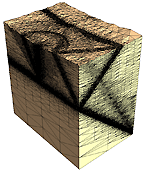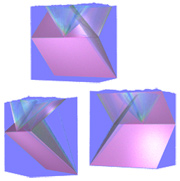Objective
Spacetime discontinuous Galerkin simulations produce high-order solutions defined over tens of millions of tetrahedra in potentially non-conforming meshes. Existing rendering methods cannot achieve interactive frame rates when visualizing such extensive data sets. Our goal is to render these data interactively without sacrificing accuracy or quality.
Approach
We use an interactive point-based rendering system accelerated by GPUs (Graphics Processing Units). We adaptively sample tetrahedra in streaming fashion, decimating points at run time according to importance to fit the GPU memory limits. The memory consumption is independent of the input size. Our order-independent point rendering method can render on the order of 20 million tetrahedra at interactive rates. Our approach is about 200 times faster than the widely-used ray casting method, with no loss in fidelity.
Impact
This work provides a powerful tool for interactively visualizing high-order solutions with sharp, shock-like features. It naturally extends to general nonlinear conservation laws and should prove valuable in fluid dynamics, earthquake simulation, seismic petroleum exploration and nondestructive methods for detecting internal flaws in metal castings and weldments. Our fast rendering method can also be used to visualize 3D data in space only, as in medical imaging.
This material is also available in a Powerpoint slide "nugget".

![]()
